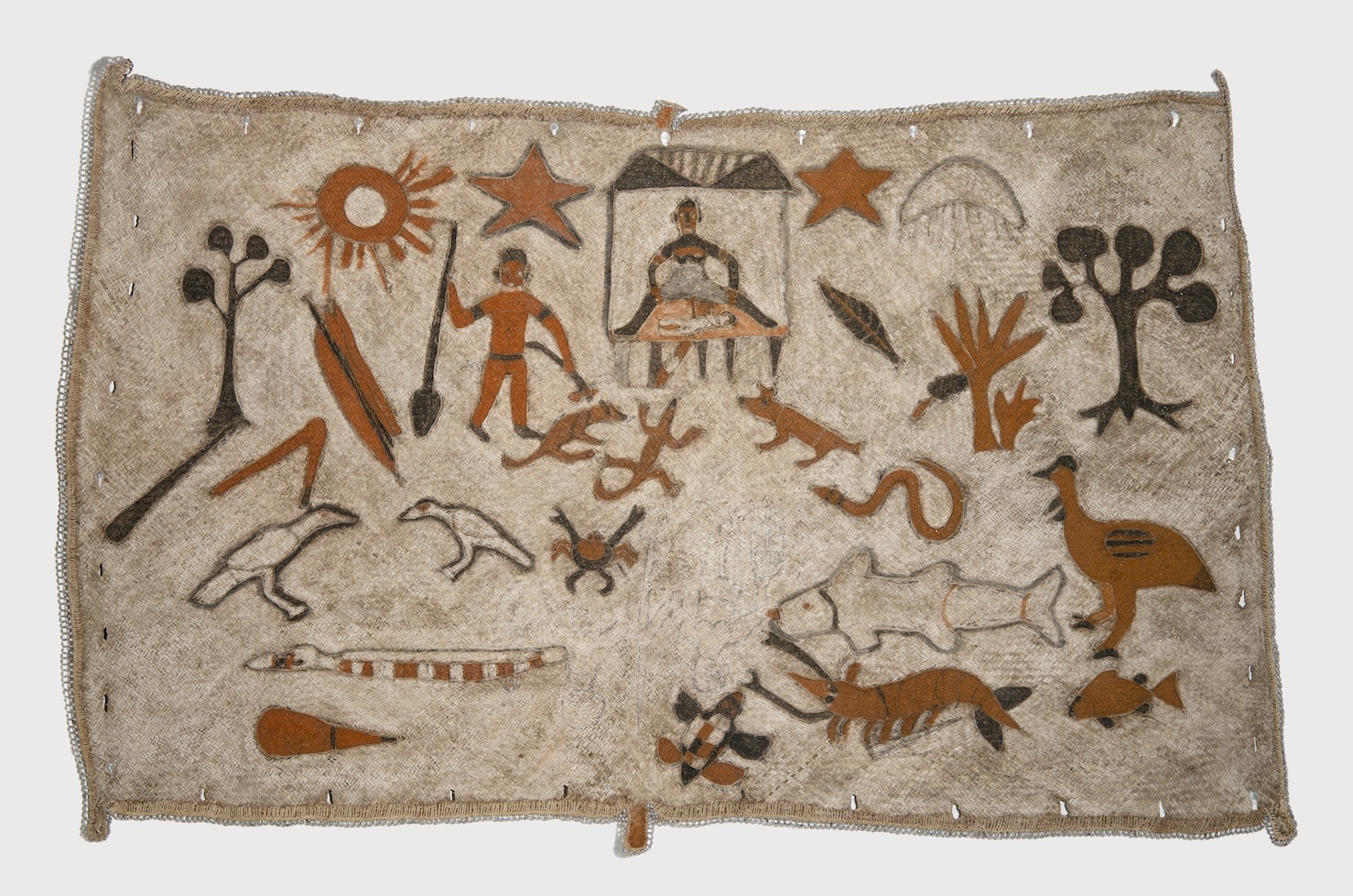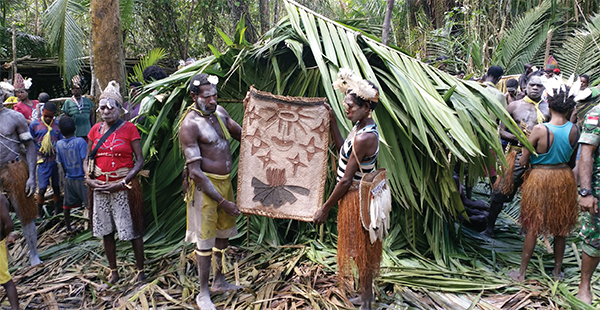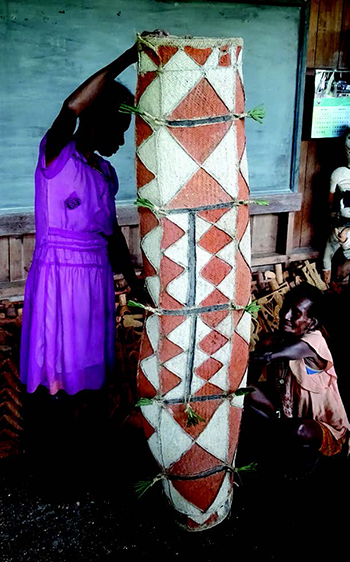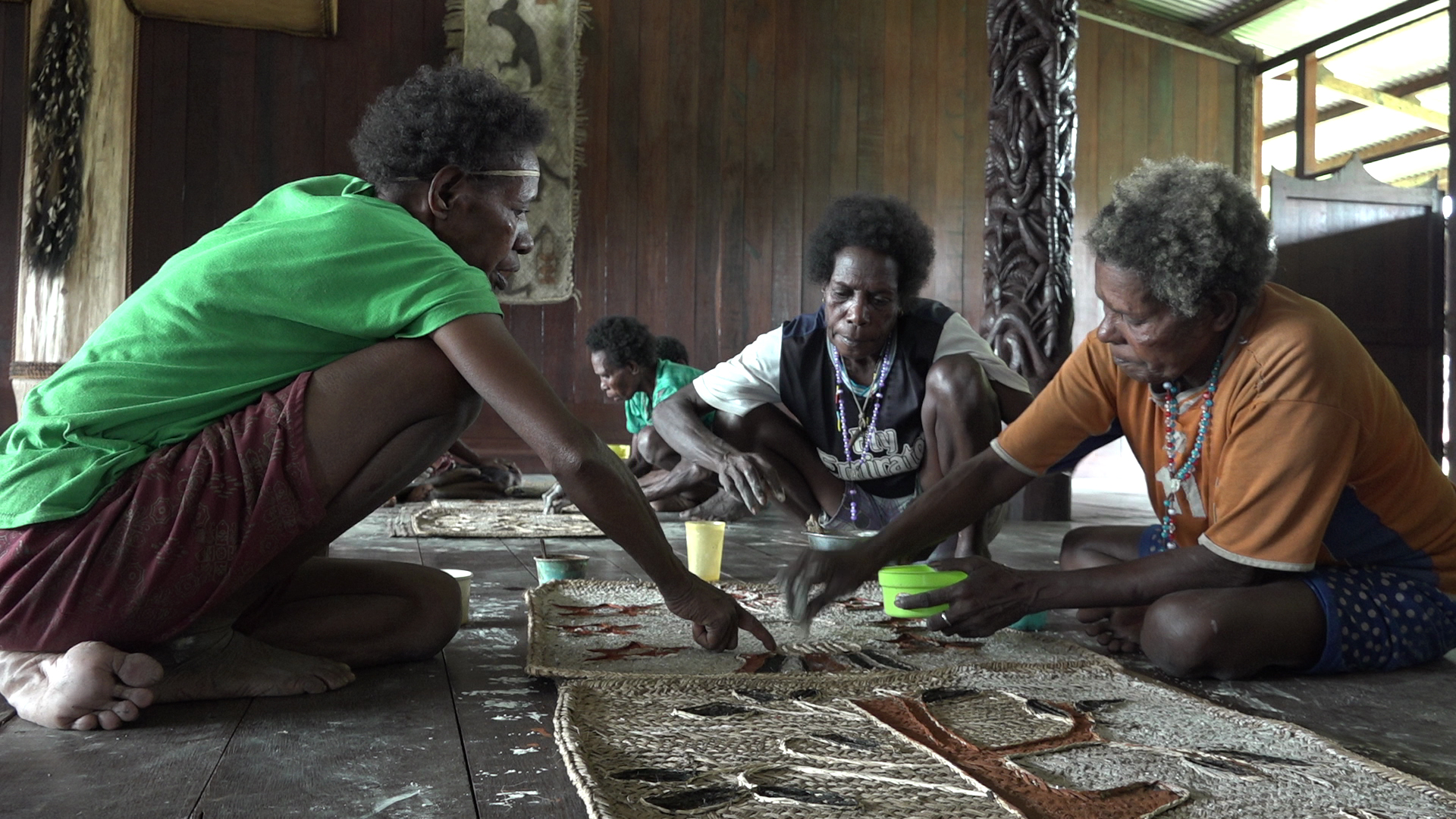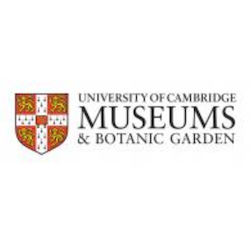- Tradition and invention in Asmat ritual
- Christmas and the Jimi Pir feast
- Commissioning the collection
Tradition and invention in Asmat ritual
For generations, Asmat people have negotiated relationships with their ancestors, and with each other, through cycles of ritual. In a social world where there is no such thing as ‘luck’, relations with ancestral spirits are seen to be the cause of all success, failure, health or sickness. To repair relationships, Asmat people hold the Jimi Pir feast, which is framed around the secret production of a pir mat by women.
Asmat was first colonised by the Netherlands in the 1950s, and then by Indonesia. Feasting was suppressed because it was associated with ritual preparation for warfare. Since the 1970s, with the support of a missionary Catholic church, Asmat people have revived feasting in a pacified form. This revival has in turn transformed Catholic practices, which were reshaped around indigenous feasting. By creating innovative forms of material culture inspired by customary ritual, Asmat people mediate between ancestral spirits and a Catholic God. While Asmat men’s ritual arts, in the form of woodcarving, are widely held in museums, women’s fibre work – the focus of this exhibition – is rarely seen outside the region.
Villagers hold a pir mat during a baptismal feast in the forest. Tom Powell Davies, 2017
Christmas and the Jimi Pir feast
This exhibition looks at one particular transformation of ancestral ritual – how the indigenous Jimi Pir feast has been taken up to celebrate Christmas. Today, Christmas is marked by making a new pir mat which blends indigenous and Christian iconography. Made in secret, the pir is revealed in the church on Christmas Eve, as the culmination of a month-long feast. On Christmas Day, people mend strained relations by exchanging matching items which they have made for each other, such as Christmas bags. Where the pre-colonial version of the feast celebrated achievements in headhunting, in which the death of enemies was viewed as a source of new life, here the rejuvenation of the village is marked by rituals celebrating Jesus’ birth. Both forms of ritual action please ancestral spirits, albeit in different ways.
Ésá Natal (Christmas Bag) This innovative bag, developed for the church, combines ancestral and Catholic symbols. On the right side is the customary eé tiní motif, or crocodile vagina. The left has symbols of God’s creation – the sun, moon and stars.
Made for the museum by Balbina Bám and Fitalia Tóparamók, 2018. Pandanus, lime, ochre and charcoal.
Collected by Tom Powell Davies. MAA 2020.24
Ravaela Ep and Eva Tórasimé demonstrate the rolling of a customary pir as used in feasting. Sago grubs are poured into the pir, before being shared amongst the community. The grubs develop within the decaying trunk of sago palms and are iconic of life emerging from death.
Tom Powell Davies, 2018
Commissioning the collection
The story of how ancestral traditions have been transformed within the church is largely unknown outside of Asmat. However, making a collection of Asmat Catholic arts posed a problem. It is forbidden to sell items from the church. Through discussion with senior ritual and church leaders, it was decided to commission prototypical examples of the original Catholic textile forms, but without the taboos associated with them. Ravaela Ep and Eva Tórasimé, two senior ritual leaders, determined the content of the collection. Ravaela and Eva wanted to make a complete set of copies of each of the twelve liturgical items made by women, so that the museum would receive everything needed to hold a service. This involved making not just a collection of objects – but rather, a new category of object – which sits outside of both ritual and existing art market contexts. To ensure that God was not angry about the commission, and that no harm came to its makers, the collection was blessed with holy water by the parish priest, Fr Vince Cole, before its voyage to Cambridge.
We are very pleased that this unique collection, which was created by the women of Sawa Erma specially for the Museum of Archaeology and Anthropology, is on display at the museum. It highlights Asmat women’s achievements as makers, and the determination of the Asmat people, who have remade missionary religion in the image of their ancestral life.
Ravaela Ep directs Virginia Tómbair and Bibiana Kákan in the painting of a pir mat for the museum. Photo by Tom Powell Davies, 2018
Acknowledgements:
Church and the Ancestors: Sacred pir mats from Asmat, Papua, Indonesia is curated by Tom Powell Davies and Sophie Hopmeier with the assistance of Anita Herle.
The museum is grateful to the women of Sawa Erma: Eva Tórasimé, Ravaela Ep, Balbina Bám, Monika Mándepók, Maricé Tótinakáp, Bibiana Kákan, Virginia Tómbair, Monika Tótirú, Kasparlina Tóyakas, and Fitalia Tóparamók. Thanks also to Fr. Vince Cole (MM), Bishop Aloysius Murwito (OFM), Marcus Mbes, Adam Ndo, Rufus Satí, Vincent Túman, Panahan Parapat, the Parish of Sawa Erma, the Agats-Asmat Diocese, Roy Villevoye, Paul Hopmeier, Nick Stanley, Martin Brown, and Sarah Faulks.
Technical and conservation support was provided by Rachel Hand, Kirstie Williams, Matt Buckley, Mark Hazelgrove, Bob Bourne, and Adrian Newman. Graphic design by Deborah Wickham and photography by Jocelyne Dudding. Thanks also to Helen Alderson and Sarah-Jane Harknett.
Support for the collection of new material for the Museum was provided by the Crowther-Beynon Fund, MAA, University of Cambridge. Doctoral research was supported by the University Fieldwork Fund, the Evans Fund, the Wyse Fund, the Richards Fund and the Anthony Wilkins Fund.


